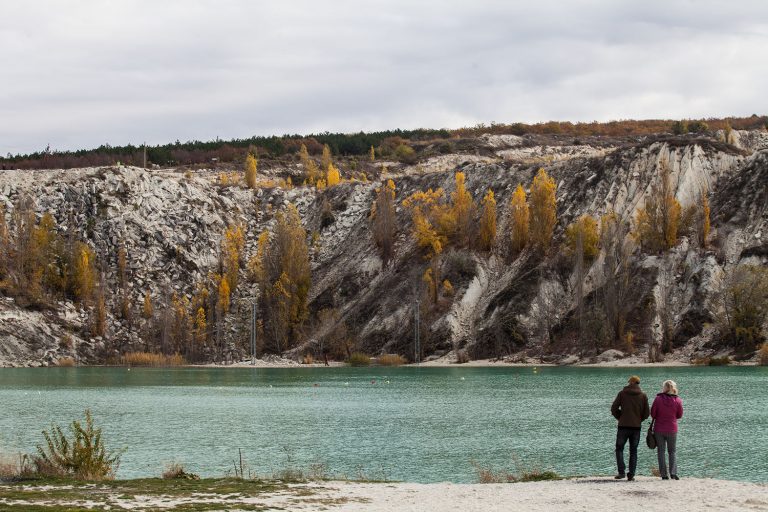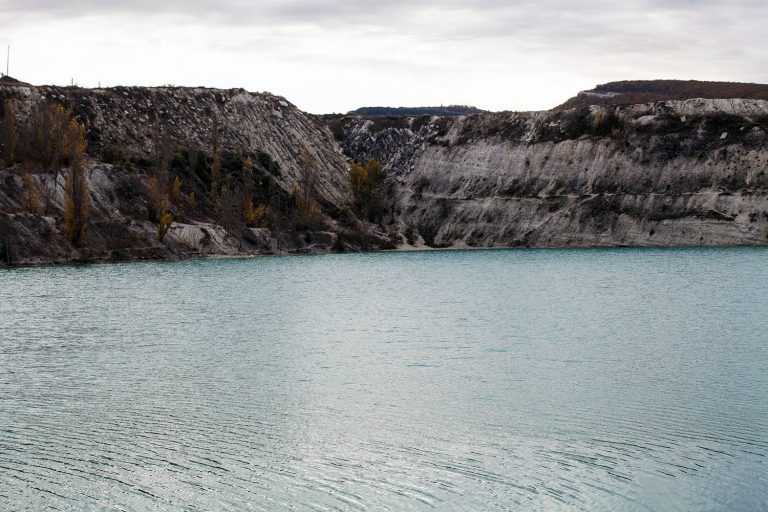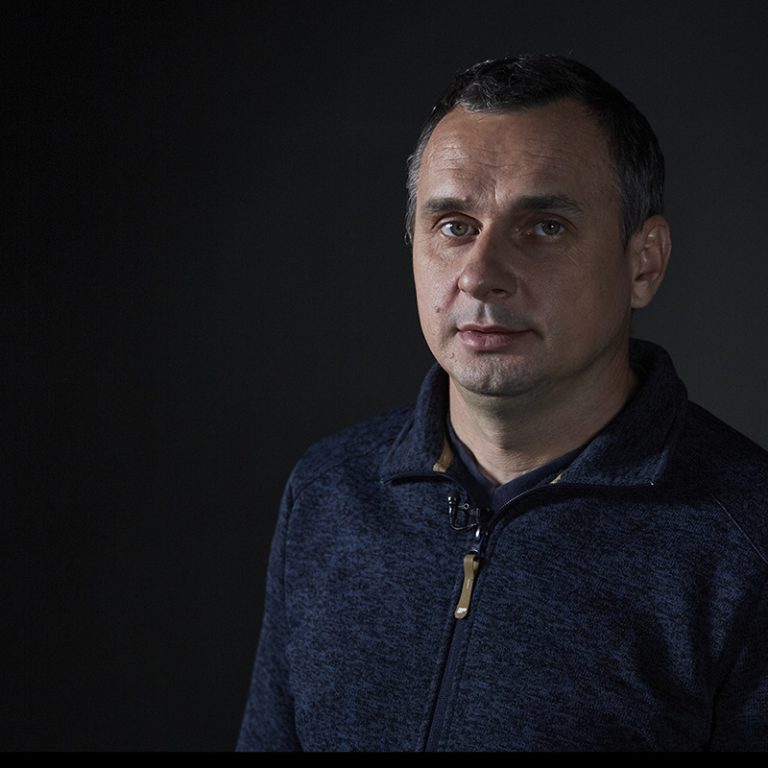Oleg Sentsov is a Ukrainian film director, scriptwriter, writer and activist. In 2014, he was arrested in Simferopol by the Russian FSB (Federal Security Service — ed.) on charges of plotting a series of terrorist attacks. After five years of illegal imprisonment, Oleg returned to Ukraine in the first exchange of Russian criminals and Ukrainian prisoners of war. He has been kidnapped, arrested and illegally convicted, and yet occupied Crimea remains off-limits to him, as well as to thousands of others.
We’re talking to Oleg before recording our interview in the studio. The walls, floor and ceiling are dark, covered with black cloth to focus the viewer’s attention on the interviewee. No unnecessary details. Oleg sits on a chair facing the camera and lights. Behind the equipment, our film crew are standing out of sight. We ask Oleg to look at the camera. He looks, and the bright light makes him squint.
— Light in my eyes, figures in the dark… Like an interrogation. Actually, they don’t use these lamps anymore, but whenever there’s an interrogation scene in a film, those movie cliches are still there. If you were trying to create the right atmosphere for a cosy chat, it’s not really working.
— Sorry.
— That’s okay.
— Could I ask you to introduce yourself?
— My name is Oleg Sentsov. In prison too, you always have to introduce yourself: you say your name, where you were born, what you’re serving your sentence for, shoe size and all that. You have to repeat these words several times per day…
May 2014. Crimean activists, described by Russia’s FSB (Federal Security Service) as the ‘Oleg Sentsov group’, allegedly planned to carry out explosions in Simferopol. The fabricated charges were based on a testimony given under torture. The occupying authorities sentenced Oleg Sentsov to 20 years in a maximum-security penal colony in Russia. In May 2018, Oleg Sentsov — behind bars — started an indefinite hunger strike, demanding the release of all Ukrainian political prisoners held in Russia. The hunger strike lasted for 145 days, until the administration of the penal colony made the decision to start force-feeding Oleg. At that time, in cities around the world, mass protests were held in support of Sentsov. With his endurance, Oleg Sentsov embodied the struggle against the totalitarian system.
The Kremlin is well known for persecuting social activists and detaining political prisoners. In 2014, with Russia’s occupation of Crimea and the start of the war in Donbas, the problem grew in scale. Many Ukrainian citizens began to be detained on charges of ‘terrorism’ and ‘espionage’. Seven years into the occupation and the war, the legislation on political prisoners in Ukraine has not yet been finalised. Human rights activists and NGOs who follow the situation are unable to determine the exact number of political prisoners held by the Russian Federation.
As of October 2020, the ‘Memorial’ Human Rights Centre has 362 people on its lists of political prisoners (which they recognise to be incomplete). These people, often given real prison sentences, can be accused of various ‘crimes’: calling for actions against Russia’s ‘territorial integrity’ (for example, not recognising the temporary occupation of Crimea), ‘planning terrorist attacks’, and ‘extremism’. The Kremlin then tries to use these prisoners to put pressure on Ukraine in political negotiations.
In the series “We are Crimea”, created in collaboration with the Ukrainian Institute, our guests revisit Crimea through a VR headset, and share their thoughts and stories about the peninsula they call home.

Photo by Serhii Korovainyi
Oleg
During Ukraine’s Revolution of Dignity in 2013–14, Oleg Sentsov went to Kyiv and became an activist with AutoMaidan (a car-based protest movement that began in parallel with Euromaidan — ed.). When the occupation of Crimea began, he made deliveries of food to Ukrainian soldiers who were stuck on the peninsula.
— I understood the nature of modern Russia very well, that it’s the Soviet Union 2.0. It hasn’t been able to give people an idea, a national idea. People need to follow something important. Something that you can’t touch with your hands, but that will be in your heart. That’s what came with Maidan, but other destructive processes started at the same time: the occupation of Crimea and Donbas, the war with Russia. It divided people, but these moments were very clear-cut: “I’m on this side, and I don’t have anything in common with the other side”.
Oleg Sentsov thinks Crimea has an ‘island’ mentality, meaning Crimeans feel they ‘stand alone’. Ukraine’s domestic policy should have taken this detail into account.

Photo by Oleh Pereverzev
— Crimea has always considered itself as somewhat separate. Ukraine’s somewhere over there, but you’re from Crimea. It’s always been this way, and unfortunately, nothing was done to change the situation. Ukraine didn’t seem attractive to Crimea, and didn’t manage to get the peninsula more integrated. So Crimea, standing somewhat alone, was so easy to occupy. And this is a problem that goes back to the Soviet times; afterwards, in independent Ukraine, nothing was done to solve it.
Oleg Sentsov believes that the deoccupation of Crimea can only be achieved in the event of destructive ‘tectonic’ processes in Russia, leading to the splitting apart of the Russian state.
— In Russia, in recent years, I’ve been in touch with a particular stratum of the population. A lot of people there don’t like Putin, and their number is growing every year. But their opinion about Crimea is uniform — they all believe Crimea belongs to Russia. This mentality is very deep-rooted there: “we’ll capture what’s ours and we won’t give it back”. It’s disgusting, but they really do think like this. And any politician who assumes office after Putin will inevitably face a political crisis if they give up Crimea so easily.
A lot can be said about returning Crimea to Ukraine, but nobody really knows when and how it is going to happen. Nevertheless, Oleg stresses the importance of keeping this question on the agenda.
— We should talk about it everywhere: both within the country and outside its borders. We must demand its return, and work for the processes which will lead to deoccupation. Instead of trying to negotiate with this regime which is just fooling with us. They don’t want to talk about Crimea at all — I’m talking about Donbas, because in my view, it’s the same thing, another case of aggression by the Russian Federation. We must fight against it for our land and everything we have.
Places where Oleg grew up. Skalyste and Bakla
Oleg tells us he has been everywhere in Crimea as he loves to travel, and driving around the peninsula is so easy: it takes less than two and a half hours to drive from the centre of Simferopol to the most distant point (Kerch, for example). Plus, the landscapes are very diverse: forests, mountains, sea, steppes, and deserts.
— I’ve spent all my life in Crimea. I was born there and only ever lived there. Although I travelled a lot, I spent my entire childhood and youth there. It’s a really great place. Then when I travelled around Ukraine and the world, I realised that nowhere could be better than Crimea.


slideshow
Oleg’s most cherished memories are connected with the village of Skalyste, where he was born and spent his childhood (he went to Simferopol at the age of 17 to begin his university studies). Skalyste (or Tav-Badraq, as it was known before 1945, based on its Crimean Tatar name) is a village halfway between Simferopol and Bahchesaray. The village is most famous for its flooded limestone quarry, also known as Marmurove (Marble — tr.), or ‘Martian’ lake.
— I used to come to this quarry to play with my friends, when we were kids; later it was filled up with water. This lake is amazing. When they filled it up with water, no one knew about it except the locals. When I said, “Listen, it’s such a great place,” [they would answer], “What could be so great in your Skalyste?” And now it’s a cult destination; people from all over Crimea come here to see the lake and swim in it.
In Skalyste there are limestone deposits and the Alma Building Materials Factory, which is engaged in the extraction of natural limestone. As Marmurove lake was formed in a limestone quarry, its water has a pure turquoise colour.
— The water was so blue, so beautiful. Now it’s a bit muddy because the steppe is being slowly washed away. Right now the water level is a bit higher, some thickets have appeared, it’s gradually getting overgrown. I recognise this place. I have it as my cover photo on Facebook because it’s the main landmark in the village. The lake is only 500 metres from my house, a five-minute walk.

Bakla
A few kilometres from Skalyste, on a steep slope of the inner ridge of the Crimean Mountains between the Alma and Bodrak rivers, is Bakla. Around the second half of the 3rd century, a fortified settlement was founded here, which later grew into a cave city. In 1299, unable to withstand the attacks of the Golden Horde, the city fell into decay. This is not the only place in Crimea where you can see the remains of a cave complex, since in the Middle Ages a large part of the settled Crimean population lived in the highlands. Cave cities such as Mangup Kale, Chufut Kale, Bakla and Eski Kermen still look much as they did in ancient times, as people stopped settling and building homes here, moving instead to more convenient valley locations.
The caves hollowed out of the rocks were used for various purposes: as dwellings, defences, or premises for storing cereals, keeping cattle, and winemaking. The remains of a temple and rock-cut tombs have also survived to this day.
— I used to come here with my friends and family. A little further, after walking through the forest for an hour, it gets really beautiful. It’s a good place to relax at the weekend. And of course, any tourists who come to the area always visit this place, because it’s so beautiful.
supported by
This publication was produced jointly by Ukraïner and the Ukrainian Institute.


